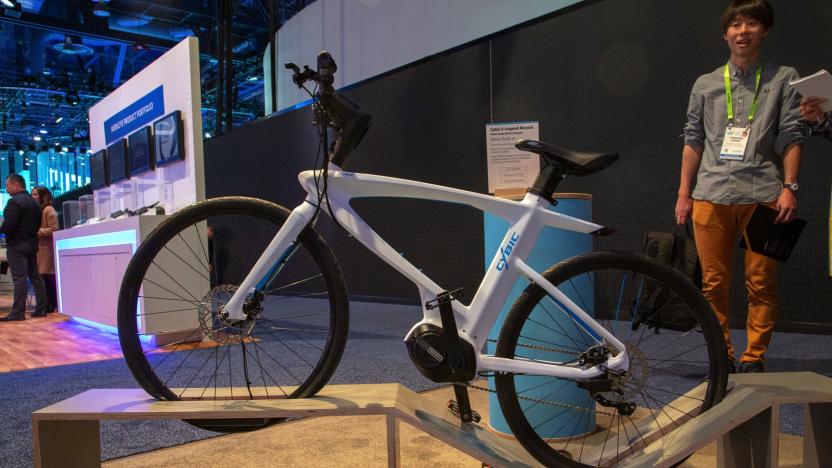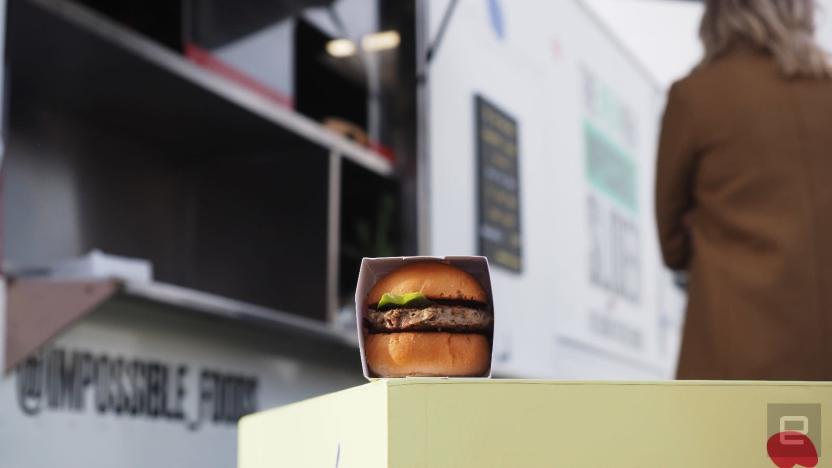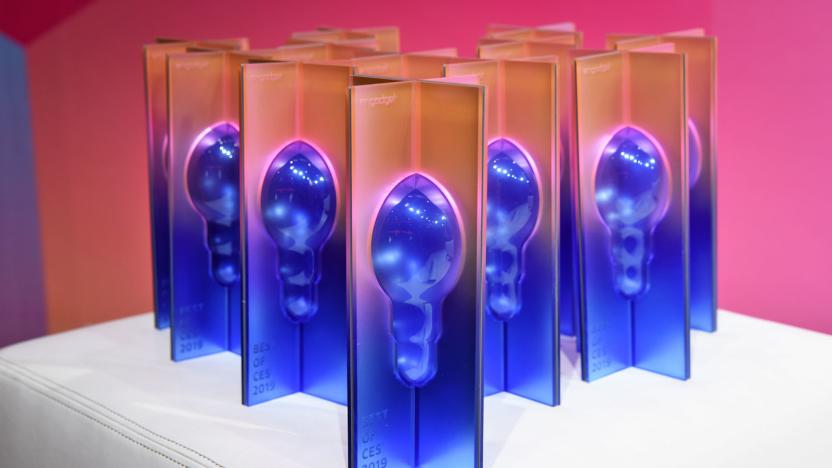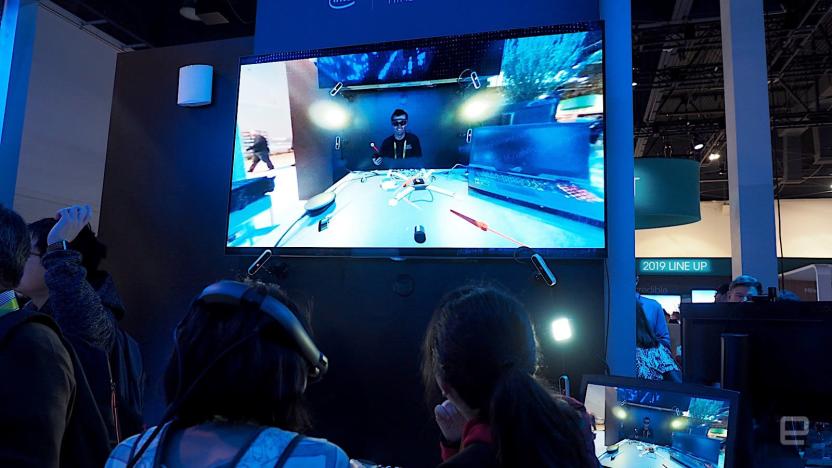ces2019
Latest

Toposens drew inspiration from bats for its low-cost sensors
Stick with us here for a second: if you're building a robot or an autonomous car, you're going to need some sensors to help your creation "see" what's around it. 3D-sensing cameras will do the trick, as will laser-based systems, but German startup Toposens is trying something a little different. Instead, Toposens has built (relatively) inexpensive sensors that map their surroundings using 3D ultrasound -- a worldwide first, if they're to be believed.

LG's Laser 4K doesn't need a lot of space for a big picture
LG isn't the first company bringing a 4K short-throw projector to CES and it inevitable will not be the last. What the company claims, however, is that with its subtle design and AI-powered voice control the CineBeam Laser 4K could realistically blend into a living room until you suddenly feel the need to watch a 90- or 120-inch display. Sure, you could always get a hideaway rolling OLED screen to do the same job, but even without revealing the price I'm going to assume this will be a cheaper option.

FenSens gives your clunker the same backup sensing as modern cars
Remember when CES wasn't flooded with car news? We don't. None of us are about to complain about cars becoming more intelligent and customizable, but these advances do little to help people who have cars that are more than a few years old. That's where FenSens comes in: this Seattle-based startup has developed an aftermarket rear sensor you can stick to the back of your car, just to make sure you don't take anyone out when you're about to leave the grocery store.

AMD's CEO and CTO on Radeon VII, ray tracing and beyond
After lagging behind with Vega desktop GPUs for a few years, AMD announced a major upgrade today: the Radeon VII, the first 7nm GPU for gamers. It's a powerful card capable of serious 4K performance. Its new architecture means it won't use up too much power, leaving plenty of room for overclockers to take it even further. But there's no real-time ray tracing, a technology that NVIDIA has been pushing since last year, when it unveiled its RTX desktop GPUs. So where does this leave AMD?

The Honor View 20 squeezes lots of quirks into a gorgeous body
To say Huawei has a complicated relationship with the United States is a pretty massive understatement, but it's still here at CES showing off laptops, a mobile photo printer and the surprisingly nice Honor View 20. (A note for people who don't routinely follow Chinese phone makers: Honor is Huawei's budget phone brand.)

Breaking down the Google Assistant news and strategy for 2019
You can't escape the Google Assistant at CES 2019. Not only did the company set up a massive booth, complete with a mini roller coaster-like train ride, but it also has a giant gumball machine parked in front of the entrance to the convention center's Central Hall. Google also announced a torrent of new Assistant features and devices, including the Lenovo Smart Clock, the Assistant Connect platform, Interpreter Mode on smart displays, flight check-in capability, punctuations in dictated replies and more. It's clear that Assistant is not just getting more useful, but it's also going to permeate even more of our lives. Director of product management for the Google Assistant Chris Turkstra joined us on stage at CES to go over the news and give us a hint of what's coming this year.

Jack Dorsey talks NBA Twitter and Kevin Durant's burner account
Fresh off the announcement of a new partnership between Twitter and the NBA, today CEO Jack Dorsey sat down with the league's Commissioner Adam Silver at CES 2019. They talked about NBA games coming to Twitter for the first time, which won't be like any sports stream. Rather than watching a typical NBA broadcast, the Twitter camera feed is going to focus on single players, and users will be able to vote to choose whose view they want to get during a game. Dorsey said these livestreams are designed to be a "great complimentary experience" to the games you're watching on TV, rather than the primary source of entertainment.

Even bicycles have Alexa now
When I first clapped eyes on the Cybic E-Legend, I thought: "A bicycle with Alexa? What's the point?" It felt like an utterly pointless addition to a pedal-powered two-wheeler, electric or otherwise. But as I waddled around the bike at CES, I started to appreciate the concept. It can offer directions in a pinch, turn the heating on before you get home, or send a message to your family when you get stuck in traffic. Heck, you could even use it to order UberEats while you're wrapping up a weekend ride.

Neofect's robotic glove is nearly ready to help those with hand paralysis
Considering the level of spectacle you can find at CES, it's easy to forget that some companies here would rather build products that help people instead of flashy displays. Consider Neofect: we met this startup last year and found a lot to like about its NeoMano glove, a wearable that helps people who suffer from specific kinds of paralysis regain some use of their hands.

Willow CEO Naomi Kelman on designing tech for women and moms
Maybe it's just us, but we feel like we're seeing a lot more gadgets at this year's CES meant for moms: a pregnancy tracker and multiple breast pumps. I wanted to talk to someone about the challenges -- and opportunities -- of designing gadgets for women and mothers. And who better to invite onto the Engadget CES stage than Naomi Kelman, CEO of Willow? You remember Willow: The company stole CES 2017 after unveiling its wireless smart breast pump. The company managed to overcome skepticism from attendees who might have otherwise dismissed the device as just another gimmicky smart gadget -- and who might have also felt some discomfort talking about women's bodily functions. The device went on to win two official Best of CES awards that year and is now in the hands of 20,000 mothers. Kelman and her team are back at CES this year with a refined second-generation version of the breast pump. She joined me today on stage for a demo, followed by a conversation about what it means to design for women, and what others have gotten wrong in the past.

Watch AMD's CES press event in under 9 minutes
AMD didn't just respond to introductions from Intel and NVIDIA at CES 2019 -- it came out swinging. The chipmaker had plenty to show at its press event, and frequently claimed a performance edge over its rivals. The centerpiece was undoubtedly the Radeon VII, the first 7-nanometer graphics processor aimed at gamers. However, AMD had a little something for everyone, whether it was third-generation Ryzen CPUs for desktops, Epyc chips for heavy-duty number crunching and a talk about the hardware behind Google's Project Stream. That's a lot to digest, but our recap should help catch you up in a hurry.

How Impossible Foods cooked up Impossible Burger 2.0
Inside White Castle on the Las Vegas Strip I met David Lipman, Impossible Foods's Chief Science Officer, whose father was a butcher. It's a funny quirk for someone who's working to sell a plant-based product to replace ground beef. Impossible Burger 2.0, revealed this week at CES, is a major upgrade, with an improved nutritional profile and crucially, a taste and feel closer to the beef burgers that you and I eat.

Vote for the Best of CES 2019 People's Choice Award
We've announced our Best of CES finalists so now it's time for you to cast your vote for your favorite gadget at CES 2019! Just head over here (or below) to pick your three favorite items from our pool of finalists. You have until 6 PM ET tomorrow, January 10th, to get your votes in.

Presenting the Best of CES 2019 finalists!
Our editors have been hard at work the past few days finding the latest and greatest gadgets here at CES 2019. Now, after a long and arduous debate, we're ready to announce our finalists for the official Best of CES awards. Below you'll find our selections for all 15 categories, which range from best wearables to the most impactful products we've seen at the show. We'll announce our category winners tomorrow, which is also when we'll reveal our Best of the Best award recipient, the most coveted prize of all. That special award is selected from our pool of category winners. If you want your voice heard too, no worries! There's an additional category for the People's Choice, where you can vote for your favorite entry from our compilation of finalists. Just head on over to our poll to vote, and the one with the most votes will win our special People's Choice award. All award winners will be announced at a ceremony tomorrow at our CES stage, so be sure to come back right here on Engadget around 5PM PT/8PM ET Thursday to watch it all unfold.

A conference room full of holograms is the future of work
Sure, you can play immersive games and watch whales come out of the floor with Magic Leap, but another potential use case of AR is teleconferencing and work collaboration. That's mostly done via avatars these days, but at CES, a small startup called Mimesys is showing off a way to do so via live volumetric video capture. This means you can actually see your fellow collaborator face-to-face, albeit in the form of a holographic image. Mimesys set up two demo stations at the Intel booth here at CES to show off the tech. Each had a Magic Leap, as well as four separate cameras positioned on a wall in front of you. I put on the headset, and the first thing I saw was an array of what appear to be Lego bricks, that I can play around with just to get a feel of the controls. A Mimesys helper donned the other headset, and soon, he appeared in my view. He looked incredibly lifelike, and it did seem like the hologram version of him was sitting right across from me. Next, a drone appeared in front of us in a broken state, which we then worked together to re-assemble, simply by clicking and dragging on different components. All of it was done in real-time too, thanks in part to the Intel 5G network that it was hooked up to. Mimesys is hoping to sell the concept not just to the enterprise market, but also to be used in education settings, museums and even possibly for marketing and sales.

Microsoft, Samsung and Qualcomm talk connected PCs in 2019
It's been slightly over a year a year since we saw the first crop of Microsoft's "Always connected PCs." By now, we know why a laptop that's always online is super appealing, and are well aware of the trade-offs. Making better connected notebooks in 2019 requires a team effort across software and hardware makers. They'll need to address challenges in educating the consumer, figuring out how to enable the sale of bite-sized chunks of data, as well as the evergreen desire for faster performance. One our stage at CES 2019, we talked to the following executives from Microsoft, Samsung and Qualcomm about their plans to improve connected computing in 2019, and how 5G will impact it all. Microsoft: Pete Bernard, Principal General Product Manager, Silicon Partnerships Samsung: Shoneel Kolhatkar, Senior Director, Mobile Computing Qualcomm: Don McGuire, Vice President, Global Product Marketing

Lime's Emily Warren on rapid expansion and regulatory struggles
Lime is arguably the biggest player in inner-city electric bike and scooter rentals. Despite having only existed for around 18 months, the company now operates in over 100 cities across the world. On Engadget's CES stage, I sat down with the Lime's Senior Director of Policy and Public Affairs Emily Warren, to recap the company's explosive growth and global expansion. We also discuss the controversy surrounding this new rental model, Lime's next-generation scooter, regulatory challenges and how the company hopes saturation is the biggest problem it faces as it looks towards the new year.

The Hiiga-One is a mechanical bench press that doesn't need weights
The Hiiga-One workout system stands out immediately, even in the middle of a busy CES hall packed with flashing, swirling, blinking and thumping gizmos. It's a towering, weight-free, mechanical bench press machine outlined in white and with two strips of lights running down the supports on either side of the barbell. Hiiga-One is a friendly-looking, data-hungry beast, and it's designed to turn users into beasts as well.

Samsung's Galaxy Home is here at CES, and you can (sort of) talk to it
When Samsung revealed its oddly shaped, Bixby-powered Galaxy Home last year, many of expected the company to launch it immediately. That, uh, didn't happen. It's been five months since then, and Samsung still refuses to discuss when its first smart speaker will go on sale, or how much it'll cost when it does. Hell, even though Samsung has trotted out the speaker a few times since that day in Brooklyn, it generally hasn't let members of the public actually talk to it. At this year's CES, though, that changed — sort of.

How Google's hardware helps Chrome OS look its best
In the past two years, Google has stepped up its efforts to bring its own Pixel computing devices to market, but its portfolio is a mixed bag. Some devices, like the Pixelbook, have become cult favorites, while the Pixel C and Slate are more polarizing. Though those tend to be twice or thrice as expensive as similar devices by other manufacturers, Google sees its products as a canvas to show off the best possible configurations. This way, said director of product management for the Made by Google compute division Trond Wuellner, it can "inspire innovation across the ecosystem. He joined us on stage at CES to talk about lessons learned and what to expect in 2019.












